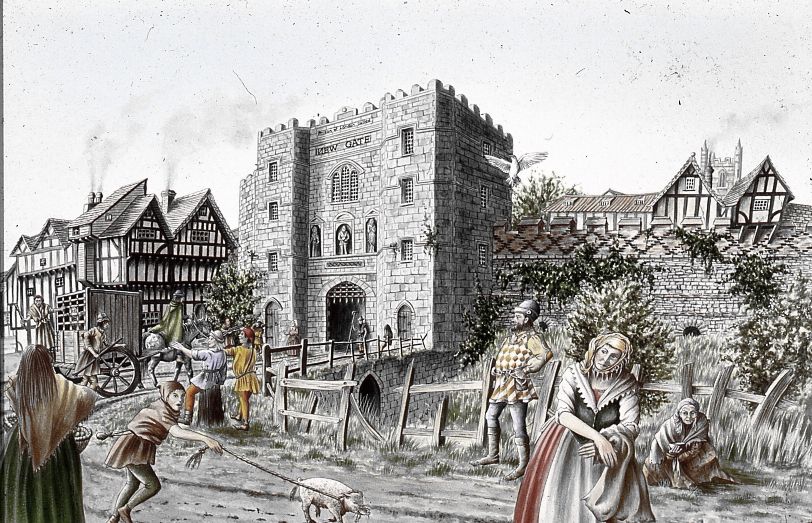Here are listed the public guided walks and tours I have in my diary. I will be adding others all the time.
Tudor London – The City of Wolf Hall 11.30am 13th July 2025 To Book
Jane Austen’s London Anniversary Walk 3pm Sunday 13th July 25 To book
Roman London – Literary & Archaeology Walk 11.30 am Sat 2nd Aug 2025 To Book
Chaucer’s Medieval London Guided Walk 2:30pm Sat 2nd Aug 2025 To Book
Myths, Legends, Archaeology and the Origins of London 11.00am Sat 11th Aug 2025 to Book
The Archaeology of London Walk 6.30pm Fri 3rd October 2025 To Book
Chaucer’s Medieval London Guided Walk 11:30pm Sat 4th Oct 2025 Aldgate Underground To book
Jane Austen’s London Anniversary Walk 2.30pm Sat 4th Oct 25 To book
The Decline And Fall Of Roman London Walk 11.30pm Sat 8th Nov 25 Exit 2 St Pauls Underground Station To book
The Rebirth Of Saxon London Archaeology Walk 11.30am Sun 23rd Nov 2025 To Book
Charles I and the Civil War. Martyrdom Anniversary Walk Jan 30th 2026 To book
For a complete list of my guided walks for London Walks in 2025 look here
Haymaking time & the Wrong Time to Marry July 2nd

‘They that wive twixt sickle and scythe shall never thrive’
The time between Haymaking and the corn harvest was such a busy period, that it was considered a bad time to marry. Haymaking was done by hand with a sickle, these were swung at an angle to cut the grass. It was easier if a good rhyme could be set up. The first man would step out to start cutting, but the next man had to leave a little gap to ensure he was safe from his fellow’s swinging sickle.
Apparently, the song ‘One Man went to mow, went to move a meadow’ gives the right gap, the second man would come in with the next line ‘Two Men went to mow, went to move a meadow’ and so on.
Once cut, the grass needed to be dried out in the fields, and turned every so often with a pitchfork. Once dried, it was taken to the farmyard and the hay built into a hayrick. The rick typically had a thatched roof. The hay, normally made of a mixture of grasses, was cut off from the rick by a hay knife to fed to animals in the winter.
Experiments at Rothamsted Park Grass, in Hertfordshire, have allowed scientists to study the effects of annual hay cutting. This study has been in continuous operation since 1856 which makes it the oldest continuous field experiment in the world. Among the many findings is the counterintuitive discovery that when fertiliser was evenly applied, the number of plant species declined from forty to fewer than five. Here is an article on Rothamsted Park Grass which gives interesting details.
If you wish to grow your lawn to increase biodiversity and to make it wildlife friendly, then read this is article. It is very important that we revive our battered wildlife. 97% of the UK’s semi-natural grassland has been destroyed over the last 80 years says ecologist Jack Marley. So not only should you adopt NoMowMay, but you should divide your lawn up into areas, and mow some regularly, others rarely and some every so often.

Read my post on Forecasting the Harvest.
First published in June 2023, republished in July 2024, 2025
July Julius Caesar’s Month

July is named for Julius Caesar. Originally, the Roman Month was called Quintilis, as it was the fifth month of the Roman calendar, which originally started in March. Caesar reformed the calendar in 44BC and the Senate renamed the month after him. For more on Roman Months, see my post here.
The 7th month is called Lúil in Irish and Gorffennaf in Welsh. In Anglo Saxon it was Æfteraliða, or “after-mild;”, Liða, means “mild” or “gentle,” or the period of warm weather around Midsummer. June is Arraliða, or “before-mild”.
It is on average the warmest month in most of the Northern Hemisphere, where it is the second month of summer. The star signs are: Cancer (until July 22) and Leo (July 23 onwards),

‘
July is the month of Haymaking, as you can see from the image (above from Kalendar of Shepherds). To find out more about haymaking, wait for the next post.
From the Kalendar of Shepherds comes this description of the month.
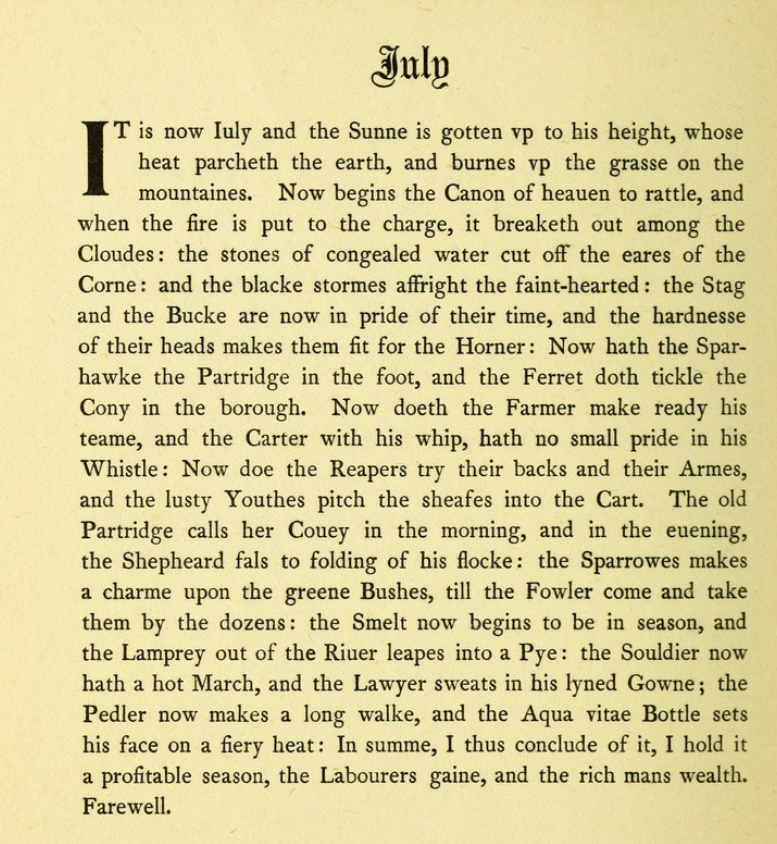
First published, in 2023 and republished in 2024, 2025
Ovid abandons the ‘Fasti’ June 30th
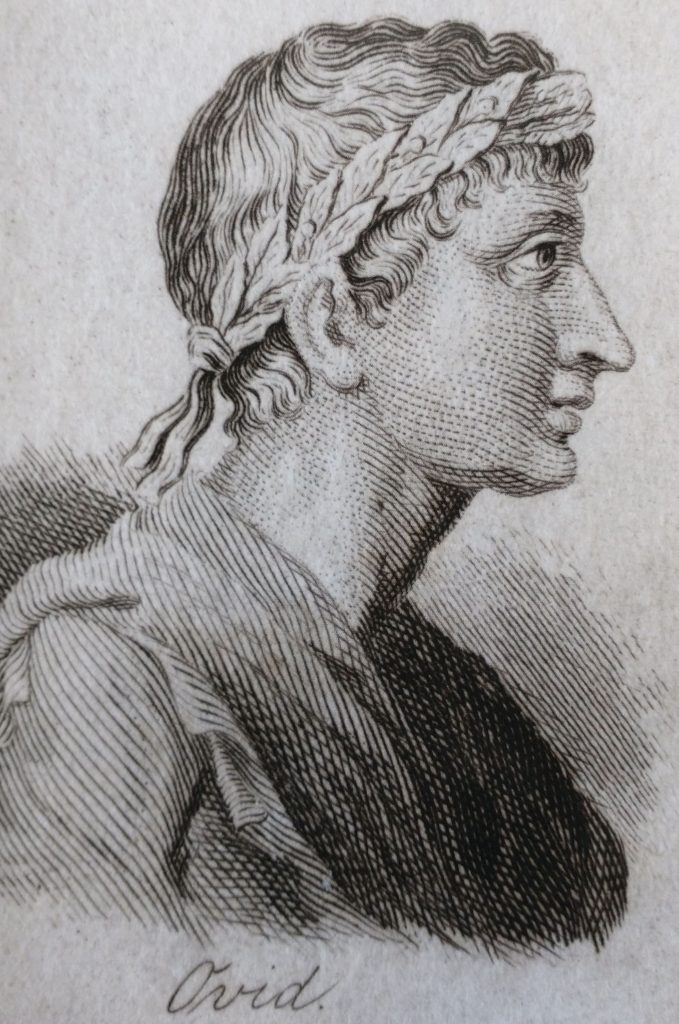
If you want to read Ovid’s almanac of the year, the ‘Fasti’, for yourself, this is the translation I am using. Fasti is very valuable because it tells the stories of the main religious and folk festivals of the Roman year. It also tells the story of the Gods and Goddesses behind the festivals,
Fasti is sadly unfinished because Pūblius Ovidius Nāsō was exiled by the Emperor Augustus. The last entry is for 30th June where Ovid writes: ‘put the last touches to my undertaking’. It suggests he knew he was finished, despite only being halfway through the year.
He was exiled to the Black Sea at Tomis where he died ten years later. It is not clear exactly why he was exiled. Ostensibly it was for the immorality of his book ‘The Art of Love’. But that was published almost a decade earlier. So, it seems a strange, delayed, cause for exile.
Was he involved with a plot against Augustus that saw the Emperor’s own daughter exiled? Her lover was Lullus Antonius, son of Mark Antony. Unlike Julia’s other lovers, he was forced to commit suicide.
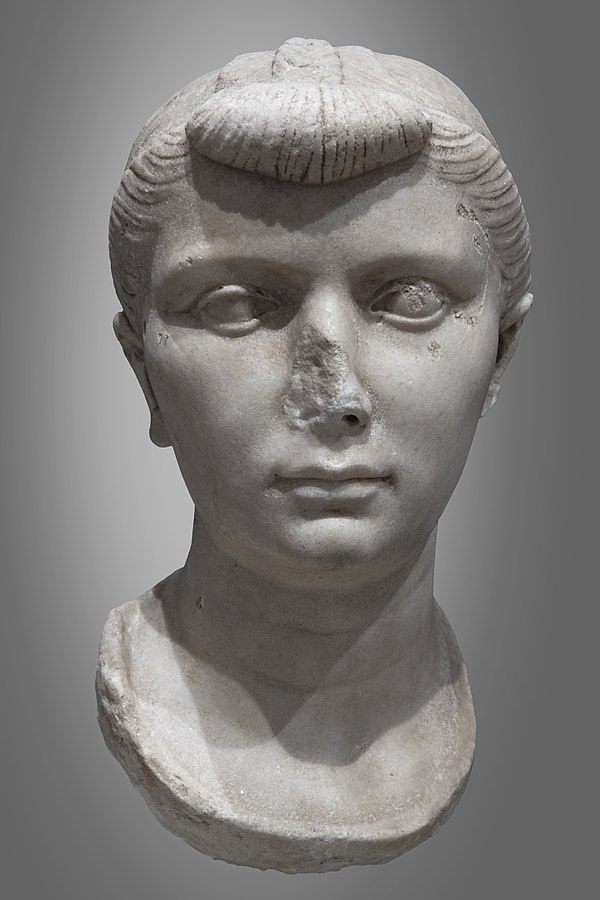
But this also happened years before Ovid’s exile. Julia’s daughter, Julia the Younger, was herself exiled closer to the time of Ovid’s exile. Her husband, Lucius Aemilius Paullus, was executed for treason. So, might this be the context of his exile? No one knows. Ovid said the reason for his exile was a ‘poem and a mistake’. The nature of that mistake is not recorded, but he said the crime was worse than murder and more harmful than poetry.
Here is one of my favourite Ovid quotations. Here he recommends how the aspiring male should dress for a night out on the town:
Don’t torture your hair, though, with curling-iron: don’t pumice
Your legs into smoothness. Leave that
To Mother Cybele’s votaries, ululating in chorus
With their Phrygian modes. Real men
Shouldn’t primp their good looks …
… Keep pleasantly clean, take exercise, work up an outdoor
Tan; make quite sure that your toga fits
And doesn’t show spots; don’t lace your shoes too tightly,
Or ignore any rusty buckles, or slop
Around in too large a fitting. Don’t let some incompetent barber
Ruin you looks: both hair and beard demand
Expert attention. Keep your nails pared, and dirt-free;
Don’t let those long hairs sprout
In your nostrils, make sure your breath is never offensive.
Avoid the rank male stench
That wrinkles noses. Beyond this is for wanton women –
Or any half-man who wants to attract men.
Ovid, The Art of Love i
The translation is from Green, Peter (Trans) ‘Ovid The Erotic Poems’ Penguin Classics, London 1982‘
Mother Cybele’s votaries were castrati, hence their high-pitched voices. The Cybele, the Mother Goddess, fell in love with Attys, who made her jealous. She made him mad, whereupon he castrated himself and bled to death. The Goddess had him resurrected body and soul. They enjoyed divine bliss ever after. A Cybelian castration device, dredged out of the Thames, can be seen in the Roman Gallery of the British Museum.
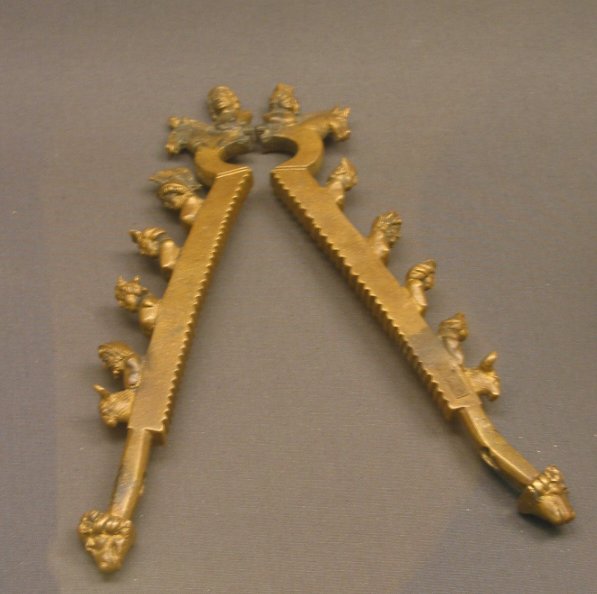
The paragraph above is a quotation from In Their Own Words – A Literary Companion To The Origins Of London‘ D A Horizons, 2009. by Kevin Flude. To buy the Kindle or Paperback version click here.
To read my post on Ovid’s Metamorphosis-crocus-and-saffron/
First Published in 2024 and revised in 2025
World’s First ATM Honoured. Digital Heritage June 27th 1967

On the 10th April 2023, Heritage England announced on its webpage, that they had listed a Bank which contained the world’s first ATM Machine. On 27th June 1967 Barclays Bank open the first ATM at its Enfield Branch in London. Above, you will see local celebrity, Reg Varney (in hat), a star of a very popular and ‘corny’ sitcom called ‘On the Buses‘ opening the new machine. It miraculously delivered a £10 note without any human intervention, and offered access to money after banking hours.

Barclay’s had previously launched the UK’s first credit card, and selected Enfield to be the place where they launched an automatic machine to dispense money. They are nicknamed ‘money machines’ in the UK. The customer was issued a ‘punched card’ and had to enter a PIN for the magic to be initiated. Barclays were developing the idea of a magnetic strip on a card at the same time.

The building, which now has a plaque and a gold-painted modern ATM, is Grade II listed and so should be protected from development in future. The building itself is an interesting, almost typical, late Victorian red brick commercial building, with fine details in the Flemish Renaissance style by William Gilbee Scott. Scott lived in Enfield.
I look forward to visiting it on my next visit to Enfield Lock on my narrow boat Mrs Towser.
For more on Digital Heritage see my post and for more on Mrs Towser see my post here
First published in June 2023 and republished in 2024, 2025
Festival of St John the Baptist June 24th
Two of the biggest feast days in London were held in late June. The Feast Days of St John the Baptist (June 24th) and of St Peter and Paul (29th June) were remarkable in the scale and the expense of the celebrations.
Here is what John Stow tells us about the processions on the night before the feast of St John (24th June) and St Peter and Paul (29th June):
On the vigil of St. John the Baptist, and on St. Peter and Paul the Apostles, every man’s door being shadowed with green birch, long fennel, St. John’s wort, orpin, white lilies, and such like, garnished upon with garlands of beautiful flowers, had also lamps of glass, with oil burning in them all the night; some hung out branches of iron curiously wrought, containing hundreds of lamps alight at once, which made a goodly show, namely in New Fish street, Thames street, etc.
Then had ye besides the standing watches all in bright harness, in every ward and street of this city and suburbs, a marching watch, that passed through the principal streets thereof, to wit, from the little conduit by Paule’s gate to West Cheape, by the stocks through Cornhill, by Leaden hall to Aldgate, then back down Fenchurch street, by Grasse church, about Grasse church conduit, and up Grasse church street into Cornhill, and through it into West Cheape again.
(Grasse Church Street is Gracechurch Street.)
The whole way for this marching watch extendeth to three thousand two hundred tailor’s yards of assize; for the furniture whereof with lights, there were appointed seven hundred cressets, five hundred of them being found by the companies, the other two hundred by the chamber of London.
(Note a cresset is: a ‘metal container of oil, grease, wood, or coal set alight for illumination and typically mounted on a pole’ (Wikipedia).)
Besides the which lights every constable in London, in number more than two hundred and forty, had his cresset: the charge of every cresset was in light two shillings and four pence, and every cresset had two men, one to bear or hold it, another to bear a bag with light, and to serve it, so that the poor men pertaining to the cressets, taking wages, besides that every one had a straw hat, with a badge painted, and his breakfast in the mornings amounted in number to almost two thousand.
The marching watch contained in number about two thousand men, part of them being old soldiers of skill, to be captains, lieutenants, serjeants, corporals, etc., wiflers, drummers, and fifes, standard and ensign bearers, sword players, trumpeters on horseback, demilances on great horses, gunners with hand guns, or half hakes, archers in coats of white fustian, signed on the breast and back with the arms of the city, their bows bent in their hands, with sheaves of arrows by their sides, pike-men in bright corslets, burganets, etc., halberds, the like bill-men in almaine rivets, and apernes of mail in great number;
There were also divers pageants, morris dancers, constables, the one-half, which was one hundred and twenty, on St. John’s eve, the other half on St. Peter’s eve, in bright harness, some overgilt, and every one a jornet of scarlet thereupon, and a chain of gold, his henchman following him, his minstrels before him, and his cresset light passing by him, the waits of the city, the mayor’s officers for his guard before him, all in a livery of worsted, or say jackets party-coloured, the mayor himself well mounted on horseback, the swordbearer before him in fair armour well mounted also, the mayor’s footmen, and the like torch bearers about him, henchmen twain upon great stirring horses, following him.
The sheriffs’ watches came one after the other in like order, but not so large in number as the mayor’s; for where the mayor had besides his giant three pageants, each of the sheriffs had besides their giants but two pageants, each their morris dance, and one henchman, their officers in jackets of worsted or say, party-coloured, differing from the mayor’s, and each from other, but having harnessed men a great many, etc
John Stow, author of the ‘Survey of London‘ first published in 1598. Available at the wonderful Project Gutenberg: ‘https://www.gutenberg.org/files/42959/42959-h/42959-h.htm’
Pagan Rituals
There are also pagan rituals associated with the Feast of St John. Here is an example of French pagan solstice fires:
“They were lit at the crossroads in the fields to prevent witches and sorceresses from passing through during the night; herbs gathered on Saint John’s Day were sometimes burned to ward off lightning, thunder and storms, and it was thought that these fumigations would ward off demons and tumults.”
For more information, have a look at ‘French Moments’ here:
Summer Solstice?
The Feast of St John is often described as being on the Summer Solstice, it isn’t by modern reckoning, but nor is December 25th the Winter Solstice. But they were celebrated as such by Christians, and the Solstice can be thought of as spread over 3 or 4 days (or more if taking into account Solstice Old style). The major events of the sun and the moon were linked into Christian theology and symbolism. Jesus, son of God, would clearly have arrived at the auspicious time of the Winter Solstice. His cousin, John the Baptist, came to tell the world about the coming of Jesus and so his birthday was exactly 6 months before the Winter Solstice.
St John is also special as most Saint’s Days are linked to the day of their death, but June 24th is the birthday of St John. His beheading by Herod is commemorated on 29th August.
St John Walbrook
St John the Baptist upon Walbrook in the City of London is first mentioned in the 12th Century, burnt down and not rebuilt after the Great Fire of London. The parish was, later, united with St Antholin, Budge Row, The Graveyard survived until 1884 when the District Line destroyed most of the Graveyard and the bones were reinterred below a monument, which can still be seen in Cloak Lane.
A Day Off for Anglo Saxon Freemen
In the Laws of King Alfred the Great, this day was a day off for freemen. I will be writing about Days off in the Anglo Saxon Calender on August 15th.
First published June 2023 republished in 2024, and reorganised in 2025
Brexit Day & Sins of a Tour Guide June 23rd

Today, is Brexit Day, the 9th Anniversary of that terrible day when the Brexit Referendum was lost. Brexit was a terrible term but sadly stronger than the very weak, ‘remain’. Ok you might say to your partner ‘Let’s give it another go.’ ‘Are you committed to the relationship?’ they ask. You say. ‘Yes, I am prepared to remain’. ‘All you can say is you want to remain!? Huh! Where’s the passion?’. But then the devil always had the best tunes.
Here is a survey of opinions about Brexit. To sum it up, we regret it, although we think now is not the time to reopen the wounds. But it is the time to rebuild relationships with Europe. In 10 years or so people believe we should rejoin.
We agree it was a disaster, and we blame the Conservatives and Boris Johnson most strongly, but also Teresa May. Rishi Sunak and Nigel Farage.
I posted on the other anniversary Brexit Anniversary in January here. Please be aware it features swear words, Boris Johnson and Farage.
Sins of a Tour Guide
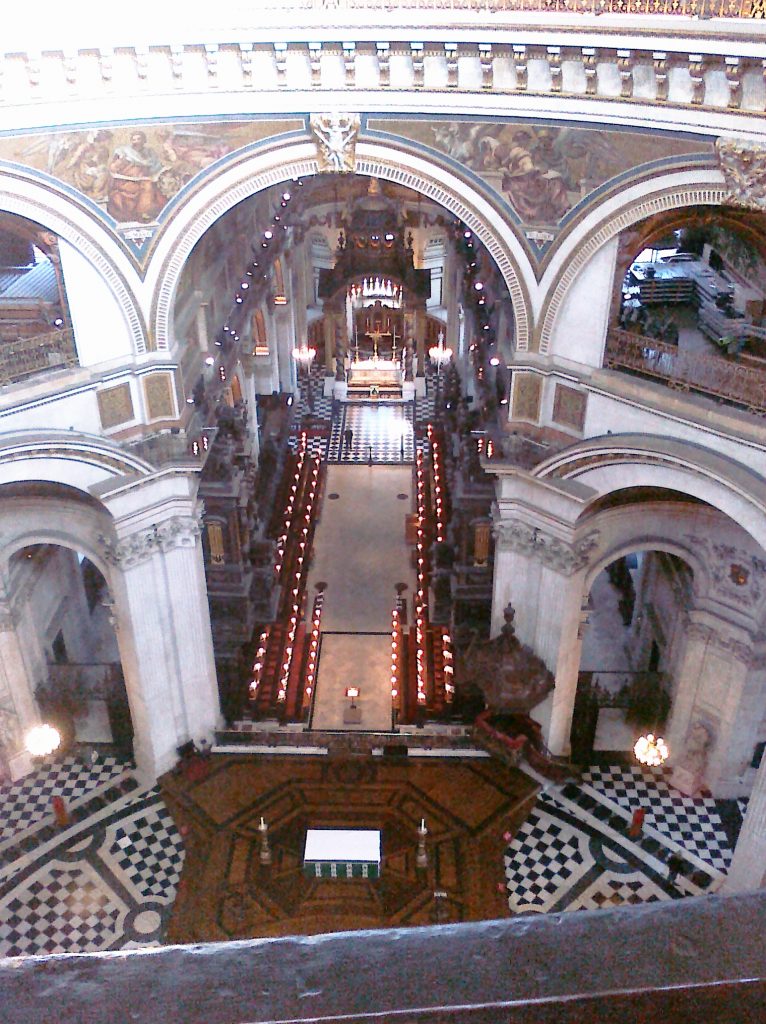
I was in St Pauls yesterday (I wrote this on 23rd June 2022) on an exploration of London’s History. My group had headsets so they can hear me talking into my mic without disturbing others. We went in, sat down in the nave to find an orchestra set up in the crossing. They were rehearsing with a grey haired man, informally dressed, at the podium. I hate talking through music, so wondered whether I would continue.
I began my introduction to St Pauls with a piece about Londinium and Christianity. A tremendous universe – shattering cord erupted from the Orchestra , deafening me. Then a pause, so I continued. I ascertained that my group could hear me, and I continued. I paused during crescendos and to some extent improvised what I was saying to the amazing drama of the atonal music. It was quite an experience and the music was amazing.
This morning I had a chance to check it out and it turns out that I spoke through rehearsals of Olivier Messiaen’s Et Exspecto Resurrectionem Mortuorum. (https://www.youtube.com/watch?v=AU7gVYM5bVE)
And the grey-haired man was none other than Sir Simon Rattle conducting the LSO.
I think I have the right piece of music.
I’m slightly shamefaced about it but on the other hand the group really enjoyed both the music and the explanation.
First written in 2022 and revised in 2025
Midsummer June 21st

Midsummer Solstice is the 21st of June. The Celtic version begins when the Celtic Day begins. This is at dusk on June 20th, which we would call Midsummer’s Eve.
Midsummer is a fire festival, dedicated to the Celtic Fire God, Belinus. His name might mean Powerful One or Shining One, and he is linked to Apollo, one of the Greco-Roman Sun Gods. His main festival is Beltane, May Day, but many of the attributes of May celebrations and indeed Halloween celebrations are also carried out at Midsummer. (See my post on May Day)
In the early medieval period, the Church hijacked Midsummer’s Day and transferred it to June 24th. St John the Baptist’s Day. John was born 6 months before Jesus. John Aubrey in the 17th Century writes:
‘Still in many places on St John’s Night they make Fires on the Hills: but the Civil Warres coming on have putt all these Rites or customes quite out of fashion.’
John Aubrey, Miscellanies, 1695
For my post on St John the Baptist’s Day read my post here.
Like May Fires, the fire should be made from wood donated from all farms in the area, and using a range of trees. Ideally, collected by 9 men and from 9 different trees. Blazing branches should be carried sunwise around the fields to bless the crops, and it was good luck to jump over the ashes of the fire.
To prepare for Midsummer, remember that it is, like Halloween, an uncanny period. Hobgoblins, Fairies and Sprites, are, as in Shakespeare’s Play, Midsummer’s Night’s Dream, all abroad making mischief.
St John’s Wort
First in the line of defence against the infernal is St John’s Wort, known as Chasse-diable, Demon Chaser, Fuga Daemonum (amongst many other appellations). It was used to keep demons away, and to exorcise haunted houses. John Aubrey in ‘Miscellanies’ talks about a haunted London house which was cured by a Doctor who put St John’s Wort under the pillow of the bed. Bankes Herbel 1525 says:

‘The virtue of St John’s Wort is thus. If it be put in a man’s house, there shall come no wicked sprite therein.’
Vervain, yarrow, corn marigold, and orpins were also used, often woven into garlands, and hung around the necks of cows, or on door lintels as protection. If the St John’s Wort withered, the picker was to die or at least endure disappointment. If orpins entwined themselves on Midsummer’s Night, marriage would follow. Orpine, (Sedum Telephium) aka Live Long, or Life Everlasting was valued for the length of time it remained fresh after being gathered. Medicinally, it was considered good to use outwardly to cool scaldings, inflammations, and wounds.
St John’s Wort has a reputation for helping with depression, menopausal symptoms, ADHD, anxiety and other conditions.

Hempseed & Love & Churches
A girl seeking love should walk around the Church seven or twelve times (accounts vary!) at midnight scattering hempseed, and singing:
Hempseed I sow
Hempseed I hoe
Let him that is my true love
Come after me and mowIn the South West of England, there was a custom to watch the church porch on Midsummer Evening. This was when the spirits of all the living people of the village could be seen entering the church. Those not seen coming out again would surely die, as would any watcher foolish enough to fall asleep.
Thanks to the ‘Customs and Ceremonies of Britain’ by Charles Kightly.
First written in June 2023, and revised and republished in June 2024, and 2025
Moneywort June 20th

Moneywort
Moneywort flowers in June/July. It is, also known as Creeping Jenny, Wandering Jenny, Creeping Joan, or Wandering Sailor. All names alluding to its rapid trailing over the ground.
It’s also called Herb Tuppence or String of Sovereigns and variations. ‘Herbe 2 pence’ was the name given by William Turner in the earliest English scientific Herbal, 1551. Turner was very controversial because the apothecaries and physicians did not want ordinary people to know the virtues of plants. Or why else would anyone employ them? So restrictive practices was the name of the game for trained medical men. So Turner, by publishing these volumes, was doing something good for the public, and bad for his fellow professionals.
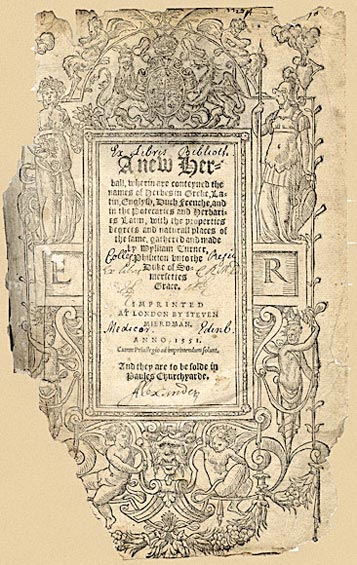
Its Latin name is Lysimachia nummularis (from the Latin for money nummulus). Mrs Grieve suggests that the two pence idea comes from the leaves which ‘look like rows of pennies, and the golden flowers which give the name String of Sovereigns.’
There was said to be ‘not a better wound-herb’, and that wounded serpents would wrap themselves around it. Hence, yet another name is Serpentaria. Also, it was thought to be good for stomachs, and against whooping cough.
It can be used both fresh or dried, but if to be dried, collect in June. It prospers in damp conditions and self-spreads.
William Turner & Ferrara
I have just come back from Ferrara. While there, we were given a tour of the Palazzo Paradiso and nearby buildings. These are town houses originally built for the Estes, the Dukes of Ferrara, in the 14th Century. In 1567, the Palazzo Paradiso was rented out to the University of Ferrara. Turner learnt his medicine in Italy in Ferrara and Bologna between 1540 and 1542. He was awarded his M.D. while in Italy. But, I’m not sure where the medical facility was in 1540. But I am not going to miss this opportunity to show some lovely medieval architecture, that Turner might well have seen. And an early modern Anatomy Theatre.




In the Tower of the building are kept the remains of Ludovico Ariosto, the great medieval Italian poet (1474 – 1533). He wrote the epic Orlando Furioso (1516).
Weather in June
Calm weather in June
Sets corn in tune.
When it is hottest in June, it will be coldest in the corresponding days in February.
(Weather Lore by Richard Inwards 1895)
To read my post on Coltsfoot and Smoking read my post here.
For more on Ferrara read my post on the Pallio.
First written in June 2023 and republished in 2024, and 2025
Death of Luca Pacioli the Father of Double Entry Bookkeeping June 19th 1517
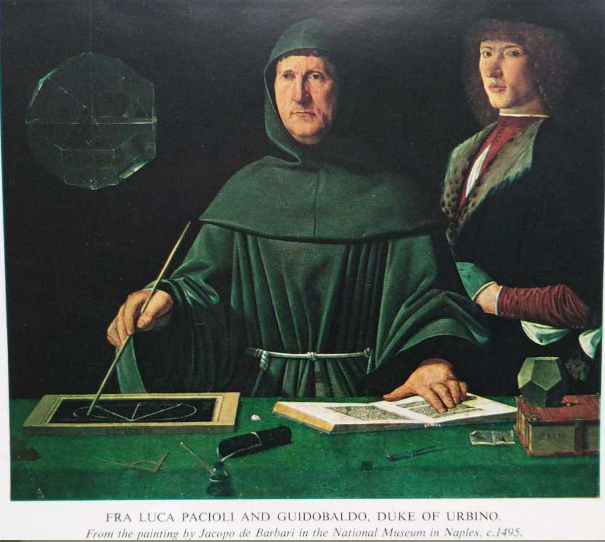
Luca Pacioli was a mathematician, whose mathematical text book had a section on Venetian book-keeping. It was published in 1494 although double entry booking keeping was probably being used earlier. The accountancy is a 27-page section called “Particularis de computis et scriptus. It is part of the compendious ‘Summa de Arithmetica, Geometrica, Portiona et Proportionali’.
It is the source of modern double entry accounting, which spread from Venice as it was the printing capital of Southern Europe.
The key discovery, reported by Luca Pacioli, was that every transaction had to have an entry in both a debit and credit account. So if I lend you £10,000 then my account is debited by 10k and yours is credited by the same amount. Fra Luca (he was a Franciscan Friar) would have it that the accountant could not go to bed until the ledgers balanced. That is, that all the credits and balances in all the ledgers balance.
Double entry bookkeeping has prevented numberless frauds, kept many businesses on the straight and narrow. But it is of course not proof against sophisticated fraud.
Assyrian Double Entry booking keeping?
The gypsum stone reliefs shown below on display in the British Museum show clerks recording booty plundered in the Assyrians’ wars. The soldiers are bringing goods in to be counted. In the first picture, the goods are severed skulls. In the second are a wide range of booty.
In every scene like this, there are two scribes writing notes on clay tablets with styli. They stand side by side. I presume their role is to make sure the other man doesn’t cheat, rather than to facilitate double entry book keeping as such. Assyrians paid their soldiers for each enemy soldier they killed, and the head was the proof. You will see a little pile of severed heads between the soldier and the scribes.
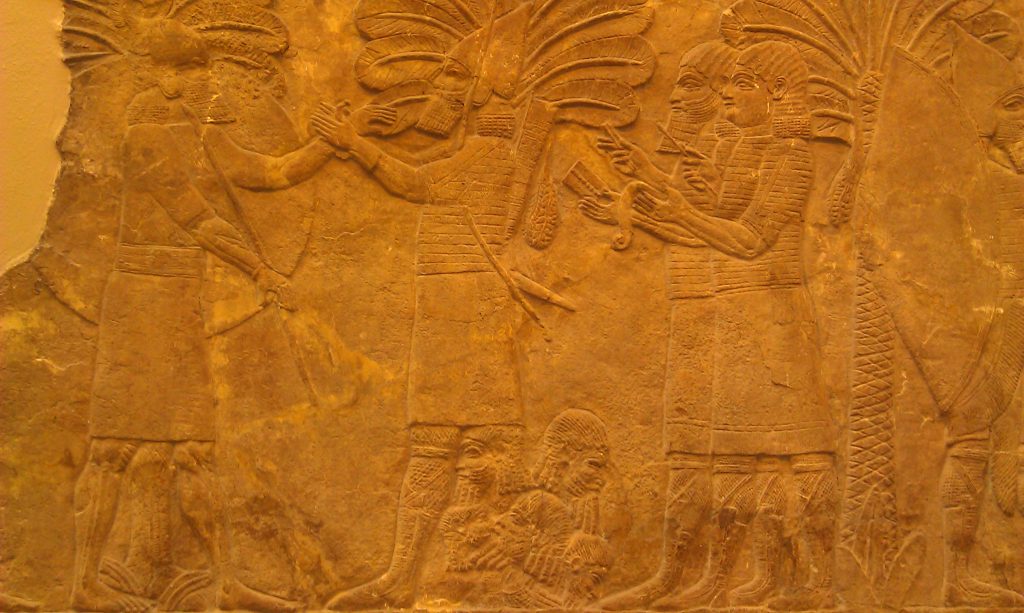
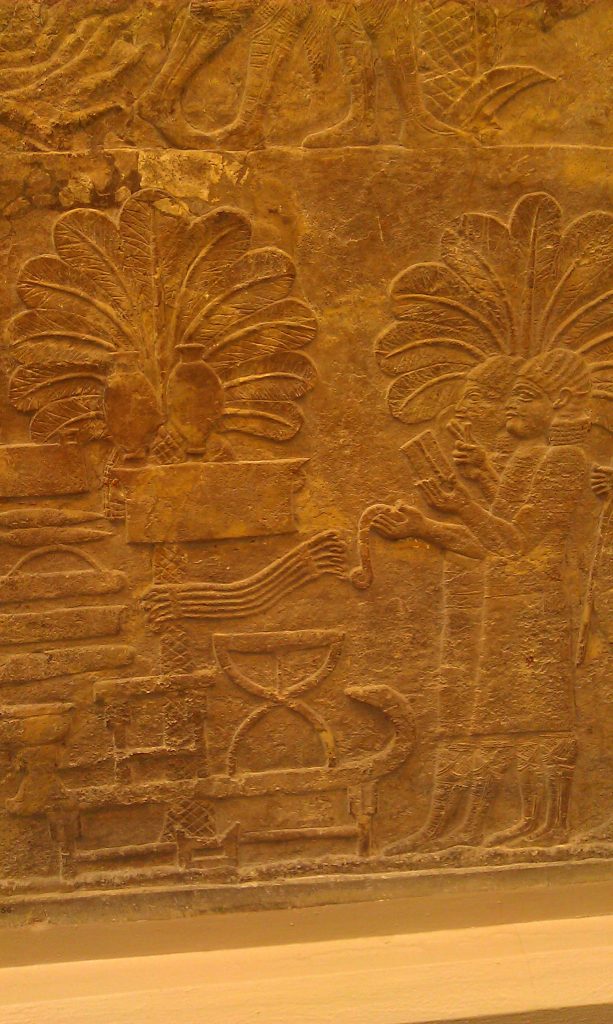
Italians, Accountancy and London.
The earliest work on double entry in England was by Oldcastle in 1543. There were a lot of Italian businessmen in Tudor London. Thomas Cromwell was friends, and indeed neighbours, with some. As a young man he was helped out by the head of one of the great Florentine Finance houses, Frescobaldi. They had branches in Bruges and London, and were major financiers to the Kings of England. Thomas More lived among the colony of Merchants from Lucca. The business centre of London before the building of the Royal Exchange was in Lombard St, where the Lombardian bankers hung out.
More on the British Museum in my post here
First Published on June 19th 2025
The Great Broadway Paint off

One of the joys of my Summer is revisiting places I know and love in my role as a Course Director for Road Scholar. I first came across the ‘en plein air’ in 2023. On Sunday, June 18th. I was in Broadway, once considered the most beautiful village in Britain. It was also the model for Riseholme in the wonderful Lucia books by E. F. Benson (made into a TV series by the BBC starring Prunella Scales, Geraldine McEwan and Nigel Hawthorne).

The day I visited, in 2025, was last Sunday, June 15th. I have added new photos and revised the texts.
How it Works
The artists register in the morning and have their paper or canvas stamped, or given a block of Maltese stone. This proves that they have done all the work on the day itself.
This year there were no sculptors. Instead, there were live models in the marquee being painted by portrait painters.

They take their blank canvases to create a work of art in the village. At 4pm or so, they are judged. At 5pm, the art works are exhibited and are on sale in the Marquee on the village green.

It’s always a delight walking around Broadway. Bun, but with an artist and easel every 50 yards or so even more enjoyable.
The Most Beautiful Village?
The appellation of most beautiful village, came in the late 19th Century. Broadway, once gained its wealth by selling wool. When that declined, the village became an important stop on the Toll Roads. It was on the stage coach route from Aberystwyth to Worcester, Oxford, and London. Fish Hill, nearly 1000 feet high, was an obstacle and coaches made a stop here to prepare or recover. Some coaches used up to 10 horses to get to the top. But with the arrival of Brunel’s Great Western Railway to the Cotswolds the village was nearly ruined. Half the village, the Broadway Museum says, moved away as their livelihood serving the coaching trade died.



But artists and writers, led by Americans Frances Millet and Edwin Abbey, turned Broadway into a much sort-after country retreat. Visitors included Oscar Wilde, J. M. Barrie, Singer-Sargeant, William Morris, Edward Burne-Jones, Gabriel Dante Rossetti, American actress, Mary Anderson, Edward Elgar, E. F, Benson. Mark Twain visited for Millet’s marriage.

Gordon Russell & Henry T Ford
What made the visit particularly interesting was the story told by the volunteer at the Gordon Russell Museum in Broadway. This is the story as I understood it:
The Russells restored the Lygon Arms in Broadway using Arts And Crafts architects. They also restored antique furniture. The son, Gordon Russell, became a leading designer of modernist Furniture. He advertised to passengers on the Cunard Line in order to attract the attention of rich American visitors. One, Henry T Ford, was interested. He came to Broadway, staying at the Lygon arms. He was taken to nearby village Snowshill, where Ford bought a Cotswolds Farmhouse, complete with Blacksmith’s workshop. They were shipped stone by numbered stone to Brentford on the Thames. Then to the London Docks and across the Atlantic. Here. Ford set them up in a Museum in Michigan where they still are!

Research suggests it’s a little more complicated, in so far as Ford purchased his first Cottage before coming to Broadway. But it still leaves a delightful story about American ideas of Quintessential English village life. For pictures see my post here. And for another look at the story look at this web site here:
By the way, Frances Millet planned to return to the States on the Titanic. He was one of the 1500 who drowned. A letter he wrote while on the ship was posted, probably in France. It is on display in the Broadway Museum (2023).

For more about Broadway, Gordon Russell and Word War 2 see my post here:
June 18th is also:
National Chocolate Ice Cream Day
First Published in June 18th 2023, Republished in June 2024, and revised in 2025
